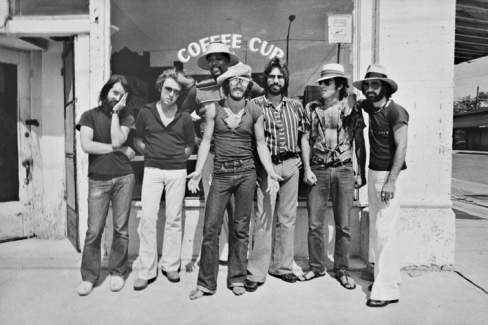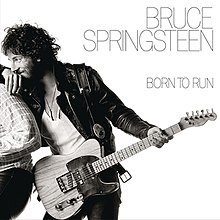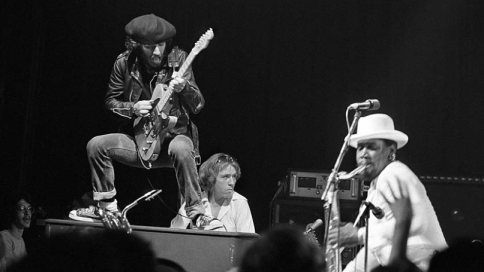This is the fourth in a series of posts that will feature detailed analysis and commentary of some of my all-time favorite albums.
***************
One of life’s true delights for rock music fans is to discover an up-and-coming artist before the rest of the world catches on. In the summer of 1975, it happened to me, and I still get chills more than 40 years later when I think about my earliest encounters with

The E Street Band, 1973: Clarence Clemons, Springsteen, David Sancious (piano), Vini Lopez (drums), Danny Federici, Garry Tallent
the music of Bruce Springsteen.
I was 20, just returned home to Cleveland after sophomore year of college. I invited several friends over and asked each one to bring an album they’d turned on to over the previous six months. Each took turns playing the best tracks from albums by a variety of great bands.
Then my friend Carp stepped up. “You’ve all had your turn,” he said. “Now get a load of this.” He lowered the needle on “Rosalita (Come Out Tonight),” the second song on Side Two of “The Wild, the Innocent and the E Street Shuffle.” Seven minutes later, we all had to pick our jaws up off the floor, totally blown away by the sheer exuberance of what we’d just heard.
Finally, I managed to say, “Holy shit! Is the whole album that good?!” He flipped the LP over and cranked the volume on another epic piece entitled “Kitty’s Back.” I was completely won over. I ran to the store the next day and bought my own copy, and found another Springsteen LP there — the earlier debut, “Greetings From Asbury Park” — and bought that as well.
From that day forward, I was a disciple of Bruce.
Why had I never heard of him before this? I learned that he was a Jersey boy, a working-class rocker with a passion for meaty rock and sweaty soul, but curiously, neither of his records had sold well. He had, however, built a solid reputation in certain East Coast pockets and among critics, who uniformly maintained, “You gotta see him live!”
Maybe so, but I was totally taken with his records. The first LP had some stellar moments — the wise-beyond-its-years “Growin’ Up,” the scrappy “It’s Hard to Be a Saint in the City,” the sensual “Spirit in the Night” and the sax-driven “Blinded By the Light” — but  “The Wild, the Innocent” was really special, full of poetic images of romance and longing, great melodies and nearly operatic arrangements.
“The Wild, the Innocent” was really special, full of poetic images of romance and longing, great melodies and nearly operatic arrangements.
As Springsteen would say in his 2016 autobiography, “In 1973, I had to have songs that could capture audiences who had no idea who I was. As an opening act then, I didn’t have much time to make an impact. I wrote several long, wild pieces that were basically the soul children of the lengthy prog rock music I’d written with Steel Mill (an early band he led). They were arranged to leave the band and the audience exhausted and gasping for breath. Just when you thought the song was over, you’d be surprised by another section, taking the music higher. It was what I’d taken from the finales of the great soul revues. I tried to match their ferocious fervor.”
He recalled some of the album tracks this way: “‘Kitty’s Back’ was a remnant of some of the jazz-tinged rock I occasionally played with a few of my earlier bands. It was a twisted swing tune, a shuffle, a distorted piece of big band music… ‘Rosalita’ was my musical autobiography up to that point. I wrote it as a kiss-off to everyone who counted you out, put you down, or decided you weren’t good enough… ‘Sandy’ was a composite of girls I’d known along the Jersey Shore, and I used the boardwalk and the closing down of the town as a metaphor for the end of a summer romance.”
Two songs — the marvelous “Incident on 57th Street” and the 10-minute strings-and-piano opus “New York City Serenade” — were dynamic stories of young love in The Big Apple, “a place that had been my getaway from small-town New Jersey since I was 16.” (Another lengthy piece in the “Rosalita” vein was the rollicking “Thundercrack,” which didn’t make  the final cut from the album but was eventually released in 2000 on his “Tracks” box set, and is included in the Spotify playlist below.)
the final cut from the album but was eventually released in 2000 on his “Tracks” box set, and is included in the Spotify playlist below.)
Meanwhile, in spring 1975, Springsteen and his group, The E Street Band, were hard at work on their make-or-break third album, and the title track, “Born to Run,” a mini-symphony of rock perfection, had been advanced as an unauthorized single to sympathetic markets. In Cleveland, we were blessed with one of the nation’s finest rock music radio stations, WMMS-FM, where savvy DJs treated us to fantastic new artists well before other cities played them. One was Springsteen, and the afternoon DJ Kid Leo made a habit of playing “Born to Run” every Friday at 5:55 pm to close out the work week.
It was an instant anthem, with a Phil Spector-like layered arrangement, a relentless full-band sound, and desperate lyrics about getting the hell out of town and “wanting to know if love is real”: “Baby, this town rips the bones from your back, it’s a death trap, it’s a suicide rap, we gotta get out while we’re young, ’cause tramps like us, baby, we were born to run…”
As Springsteen put it, “I wanted to craft a record that sounded like the last record on Earth, the last one you’d ever need to hear. It used classic rock ‘n’ roll images — the road, the car, the girl — but to make them matter, I knew I had to shape them into something

The E Street Band, 1975: Garry Tallent, Danny Federici, Clarence Clemons, Springsteen, Max Weinberg, Steve Van Zandt, Roy Bittan
fresh. It took six months to write, slowly, searching for words I could stand to sing. Then we struggled for a while to make what worked so well on stage get properly recorded in the studio.”
He was broke, he was on borrowed time, and he pushed his band to the limit. He severely tested his friendships with longtime friends Garry Tallent on bass, Danny Federici on organ, Steve Van Zandt on guitar and Clarence Clemons on sax. New members Roy Bittan on piano and Max Weinberg on drums must’ve wondered what the hell they’d signed up for.
The finished album, “Born to Run,” is one of a handful of rock albums that can truly be called a masterpiece. To my ears, there’s not a wrong note, not a weak lyric, not a single moment you wish was recorded differently. Indeed, it’s difficult to pick the best tracks, because they comprise a song cycle that segues beautifully, “a series of vignettes taking place during one long summer day and night,” as Springsteen put it.
 Let’s let the songwriter tell the story: “‘Thunder Road’ introduces the album’s central characters and its main proposition: Do you want to take a chance? It lays out the stakes you’re playing for and sets a high bar for the action to come. Then comes ‘Tenth Avenue Freeze Out,’ the story of a rock ‘n’ soul band and our full-on block party. Pedal to the metal, we steam into ‘Night,’ followed by the stately piano, organ and broken friendships of ‘Backstreets.’ Side two opens with the wide-screen rumble of ‘Born to Run,’ sequenced dead in the middle of the record, anchoring all that comes before and after. Then the Bo Diddley beat of ‘She’s the One’ before we cut to the trumpet of Michael Brecker as dusk falls and we head through the tunnel for ‘Meeting Across the River.’ From there, it’s the night, the city and the spiritual battleground of ‘Jungleland’ as the band works through musical movement after musical movement, culminating in Clarence Clemons’s greatest recorded moment, that solo. The knife-in-the-back wail of my vocal outro, the last sound you hear, finishes it all in bloody operatic glory.”
Let’s let the songwriter tell the story: “‘Thunder Road’ introduces the album’s central characters and its main proposition: Do you want to take a chance? It lays out the stakes you’re playing for and sets a high bar for the action to come. Then comes ‘Tenth Avenue Freeze Out,’ the story of a rock ‘n’ soul band and our full-on block party. Pedal to the metal, we steam into ‘Night,’ followed by the stately piano, organ and broken friendships of ‘Backstreets.’ Side two opens with the wide-screen rumble of ‘Born to Run,’ sequenced dead in the middle of the record, anchoring all that comes before and after. Then the Bo Diddley beat of ‘She’s the One’ before we cut to the trumpet of Michael Brecker as dusk falls and we head through the tunnel for ‘Meeting Across the River.’ From there, it’s the night, the city and the spiritual battleground of ‘Jungleland’ as the band works through musical movement after musical movement, culminating in Clarence Clemons’s greatest recorded moment, that solo. The knife-in-the-back wail of my vocal outro, the last sound you hear, finishes it all in bloody operatic glory.”
Wow. I’ve loved every second of this record from the day I bought it, but hearing Springsteen describe the songs like that helps me see the whole package with a new perspective. Just brilliant.
Let’s not forget the inspired album cover, which, truth be told, is best viewed when you  open it to reveal the front and back cover together in one iconic photograph. It established Clemons as “The Big Man,” Springsteen’s second in command, on record and in concert, and cemented the twosome’s friendship and partnership in a very public way.
open it to reveal the front and back cover together in one iconic photograph. It established Clemons as “The Big Man,” Springsteen’s second in command, on record and in concert, and cemented the twosome’s friendship and partnership in a very public way.
To top off my indoctrination into the World of Bruce, I was fortunate enough to see the band in concert in a 3,000-seat hall in Cleveland on August 10, 1975, just two weeks before the release of the “Born to Run” LP, and six weeks before he appeared  simultaneously on the covers of Time and Newsweek magazines. I felt as if I’d been admitted to a special club, like I’d bought stock in Springsteen just before it went through the roof.
simultaneously on the covers of Time and Newsweek magazines. I felt as if I’d been admitted to a special club, like I’d bought stock in Springsteen just before it went through the roof.
The critics were right. Springsteen in concert was exponentially more exciting than the tremendous albums.
A lengthy contractual dispute kept him out of the studio for more than two years after that, hurting his career momentum somewhat, but he came roaring back in 1978 with the powerful, hard-edged “Darkness on the Edge of Town.” Some Bruce fans I know (including my wife) prefer “Darkness” over “E Street Shuffle,” but she’s five years younger and related more to the later album because it came out as she was graduating high school. I like the album fine, certainly better than the bloated double effort “The River” in 1980, or really, just about anything since then.
 Springsteen, one of the most prolific songwriters rock has ever seen, has put together an extraordinary body of work, including many dozens of songs recorded throughout his career that didn’t see release until decades after they were recorded. There are songs on every single album that are worthy of your attention. But for me, he was never better than when he was young and hungry, embracing a do-or-die attitude, trying to go “on a last chance power drive.”
Springsteen, one of the most prolific songwriters rock has ever seen, has put together an extraordinary body of work, including many dozens of songs recorded throughout his career that didn’t see release until decades after they were recorded. There are songs on every single album that are worthy of your attention. But for me, he was never better than when he was young and hungry, embracing a do-or-die attitude, trying to go “on a last chance power drive.”
***************
The Spotify playlist below, in addition to every track from “The Wild, the Innocent and the E Street Shuffle” and “Born to Run,” includes four bonus tracks. “Zero and Blind Terry,” “Thundercrack” and “The Fever” were recorded in 1973 and slated for “E Street Shuffle” but didn’t make the final cut. (“The Fever” was one of several songs Springsteen gave to his friend Johnny Lyon for use on the 1976 debut LP of his band Southside Johnny and the Asbury Jukes, “I Don’t Want to Go Home.”) “So Young and in Love” from 1974 was originally supposed to follow “Tenth Avenue Freeze Out” on “Born to Run,” but Springsteen ultimately nixed it. All these tracks can be found on either the “Tracks” box set or the abridged version of the same package.
Pure American rock! Bruce, Billy Joel, and handful of others, were not only great song writers and musicians, but personified the American in which they grew up. Jersey Shore is baked into Springsteen’s music, as Long Island is in Joel’s. By the way, since your memory far surpasses mine in such matters, what was the name of the guy on WMMS who had those great rants following “Born To Run” each summer Friday evening back in the 1970s? “Gotta, Gotta, Gotta, GOTTA GET DOWN, DAMN IT!”
Duryea
LikeLiked by 1 person
You’re referring to the wild and crazy Murray Saul. His rants were sometimes unhinged, usually salacious, but always hilarious!
LikeLike
This is EXCELLENT! Omg…. being from Cleveland and With WMMS, I had always felt I was in on something amazing before everybody else. You captured it beautifully here, Bruce! XoB
Sent from my iPhone
>
LikeLike
Thanks, Barbara! Nothing like vintage Bruce!
LikeLike
Great post! Bruuuuuuuuuce!!!
LikeLike
I believe I bought “Born to Run” right after hearing about the Time/Newsweek double covers. I liked the album a lot initially, and then I went to Utica to see the boys live there – must have been early February of 1977. I hadn’t seen many shows at that point in my life, but instantly figured out that this would be a tough one to top. I was right.
LikeLike
Any people I know became converts once they saw Bruce in concert. Life-changing, I swear…
LikeLike
Yes, “The Wild….” is a terrific album. In fact, if I had to pick my favorite album or two of ALL TIME, “Wild” would definitely be on that list. Incredibly interesting songs. Great, deep lyrics. A level of musicianship that’s really impossible to find in other rock bands. A bunch of guys who were happy to be together in that band and having a TON of fun making music (you can hear the joy in this record). Finally, Bruce and the band managed to slip some accordion playing and tuba playing right by us. Score.
But, respectfully, The “Born to Run” album was a slight step backward in my opinion. Some of the songs on “Born” are, indeed, powerful. But, the music became a bit more cautious — intentionally I’m sure because many people did not buy into the first two Springsteen records. Albums 1 and 2 were probably “too musical.” So Bruce chose to inject more straight-ahead rock — become more “accessible.” And it worked. Can’t say I blame him. If Bruce had stuck with the same type of “Wild” formula for albums 3 and 4, sales might have remained cool — and we might have found Bruce slipping away — no longer making music. And that would have been a crime because most everything Bruce did throughout his career has at least been interesting — and often brilliant.
LikeLiked by 1 person
A thoughtful analysis, Joe, as I would expect from you. Your thoughts about “Born to Run” being more accessible has merit, for sure. Bruce knew he had to start selling more albums or get dropped from the label…
LikeLike
Part of me wonders why he didn’t sub in ‘The Fever’ for ‘Wild Billy’s Circus Story’ on The Wild and The Innocent and the E-Street Shuffle, but I guess it wouldn’t have fitted so well.
LikeLike